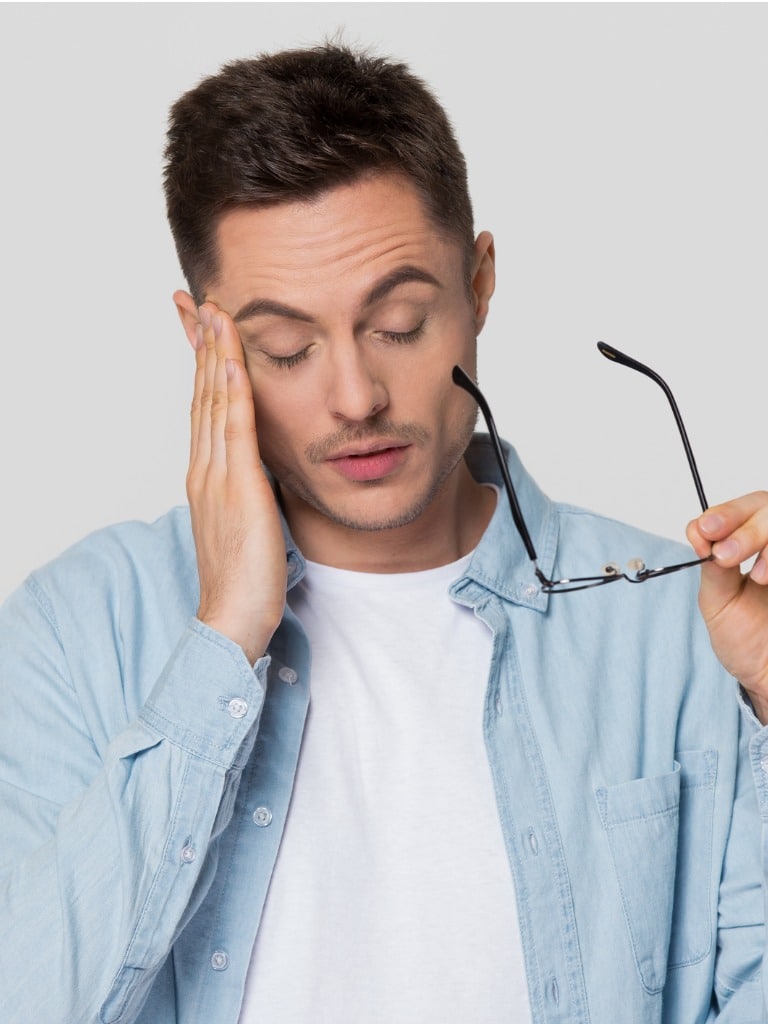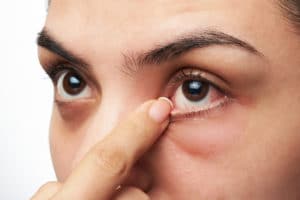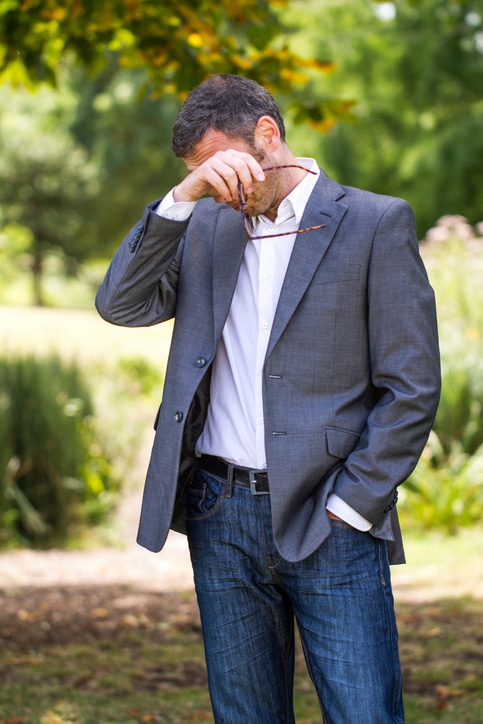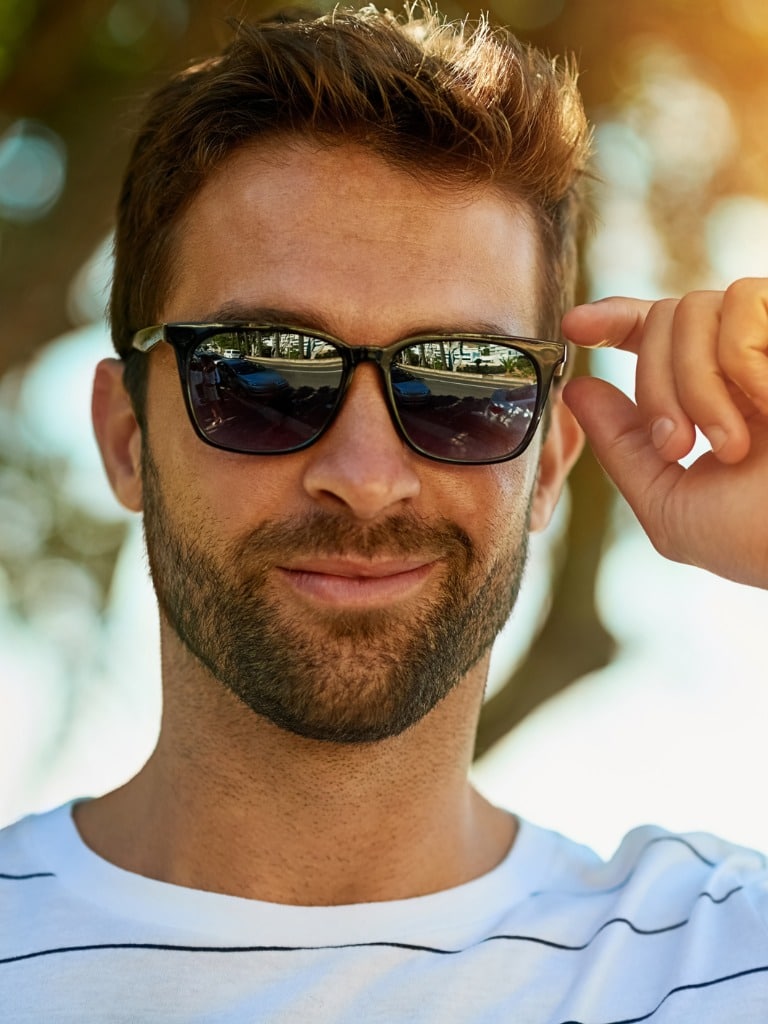What Is Dry Eye?
The Tear Film is made of a combination of 2 tear water producing glands and 1 tear oil-producing gland located in the covering of the eye and in the eyelids. A dry eye most often is due to the decrease of water and or tear oil. The result is a condition called dry eye.

How Do Tears Work?
Tears keep the ocular surface lubricated. They do so with three key ingredients: oil, water, and mucus. The oil layer is the outermost layer of the tear film. This layer keeps tears from evaporating too quickly. The oil in tears is produced by the meibomian glands. Water makes up the middle layer of the tear film. It is the most substantial layer, responsible for cleansing the eye and washing away particles that do not belong. The water in tears comes from the lacrimal glands that are located in the eyelid. The innermost layer of the tear film is made of mucus, which helps water and oil stick to the ocular surface. This part of the tear film is made in the conjunctiva.
The layers of tears are produced by the appropriate glands in vital proportions to achieve adequate moisture. When we blink, the tear film is spread across the eye and each gland involved in tear production is stimulated.
Why Does Tear Quality Matter?
Tears need to have all three layers to perform their function on the eyes. Without the right balance between oil, water, and mucus, the eyes can become irritated and susceptible to infection.
What Causes Dry Eye?
Generally speaking, dry eye can result from various problems. As we age, everyone’s tear production drops. This is especially true of women after menopause. Often, tear quality is diminished when the meibomian gland is blocked because tears evaporate too quickly from the eye without the protection of the outer oil layer. A variety of medications can also reduce tear production: antihistamines, diuretics, beta-blockers, sleeping pills, nerve medications, and pain relievers.
Dry eye really comes down to one of these (or a combination of) glands located around both eyes:
- Lack of tear water
- Lack of/or dysfunctional meibomian oil glands (tear oil)
- Both lack of tear water and tear oil
What Are Symptoms Of Dry Eye?

- Stinging or burning eyes
- Stringy mucus in or around the eyes
- Excessive tearing
- Excessive eye irritation in windy or smoky conditions
- Scratchiness on the eyes
- Discomfort wearing contact lenses
Am I A Candidate For Dry Eye Treatment?
You’re a good candidate for LipiFlow if the basis of your dry eye is the quality of your tears. When the Meibomian glands are blocked, necessary lipids are not released, so your tears don’t have the necessary oils to effectively regulate evaporation. This is the cause of dry eye in 86 percent of those with the condition. To assess your candidacy for LipiFlow, Dr. Murrell will evaluate your tears’ lipid layer and identify gland blockage.
Certain patients with various eye conditions cannot have LipiFlow. These are patients who have had ocular surgery or injury within the past 3 months. Those with active ocular infection or ocular herpes within the last 3 months. Also, abnormalities with the eyelid, such as entropion, ectropion, severe ptosis, and others, can preclude a patient from being eligible for LipiFlow.
Lipiflow Treatment For Dry Eyes
Dr. Murrell is one of the few M.D. in the United States to use two state-of-the-art treatments that are FDA approved to manage severe dry eye due to oil dysfunction: Lipiflow. This systems heat the dysfunctional Meibomian oil glands, but in different manners.
Using Lipiflow synergistically, he can give the significantly improved comfort to patients suffering from this painful condition. By taking photos and videos of your eye, Dr. Murrell can accurately diagnose dry eye and can easily show that diagnosis to his patients. Dr. Murrell then works together with the patient to create a successful treatment plan that can be performed totally or partially in office.
Dr. Murrell completed his ophthalmology residency at Texas Tech University, one of the premier Dry Eye research centers in the United States. Researchers at Texas Tech developed one of the first artificial tear drops to treat Dry Eye.
What Is LipiFlow?
LipiFlow is an FDA-cleared medical device for Meibomian Gland Dysfunction (MGD). The LipiFlow® Thermal Pulsation System has a single-use Activator through which controlled thermal energy is applied to the inner eyelids. It is called Thermal Pulsation System because, as heat is being applied to the Meibomian glands, so is gentle, intermittent pressure. In combination, heat and pressure release lipids that have become trapped in the Meibomian glands. The unblocked glands that then resume the natural flow of lipids into the tear film.
LipiFlow is a short, painless procedure that has been developed through over a decade of dedicated research and clinical testing. Featured structures and sensors protect integral parts of the eye including the cornea.
What Are The Benefits Of LipiFlow Treatment For Dry Eye?
These are great treatments, especially for frustrated patients who have tried various other treatments at home. LipiFlow is a painless treatment that provides immediate relief to most patients. By clearing the blocked or impeded Meibomian glands, normal tear production is returned. By targeting the clogged glands, LipiFlow actually treats the cause of dry eye, rather than simply calming the symptoms.
How Is LipiFlow Different From Other Dry Eye Treatments?
Many treatments for dry eye symptoms only provide short-term, fleeting relief. Eyedrops simply add fluid to the eyes temporarily. Warm compresses applied to the front of the eyelids also provide temporary relief because they don’t completely clear blocked Meibomian glands. Treatments, such as fish oil, can reduce irritation from other issues, but again they don’t clear the blocked glands. LipiFlow targets the cause of dry eye for most people — blocked Meibomian glands. That’s why it is more effective than other treatments.
Additional FAQs About LipiFlow
How Long Does A LipiFlow Treatment Take?
You’ll be in our offices for about 45 minutes to one hour. We place mild anesthetic eye drops in both eyes. Plus, we loosen any debris around the edge of your eyelids prior to your LipiFlow treatment. The actual treatment is usually done on both eyes at the same time. The LipiFlow device has two six-minute cycles. There is a warming phase, followed by intermittent pulsations, and then constant pressure.
Will I Need A Series Of LipiFlow Treatments?
For most patients, a single LipiFlow treatment works quite well. The procedure is painless, and he treats both eyes at once. The entire LipiFlow treatment takes around 20 minutes.
If you’re prone to the condition coming back, a yearly maintenance treatment is a good way to go.
What Kind Of Payment Options Are Available For A LipiFlow Treatment?
Dr. Murrell offers CareCredit financing for our patients from Amarillo and the surrounding areas. We also accept all major credit cards.
How Soon After A Dry Eye Treatment Can I Wear Makeup Or My Eyeglasses?
There are no restrictions after having LipiFlow treatment with Dr. Murrell. You can put on eye makeup and use your glasses immediately. There isn’t any recovery.
Will LipiFlow Treatments Affect My Ability To See My Phone Or Work On A Computer?
No. These are completely non-invasive treatments, and they have no recovery.
Are The Results That LipiFlow Delivers Permanent?
LipiFlow works very effectively to open the blocked glands for most patients with Meibomian gland blockage. They may remain clear permanently, but they may also become blocked again because dry eye from Meibomian gland dysfunction tends to be chronic. LipiFlow has been shown to provide results for up to two years. For patients with recurring dry eye, Dr. Murrell typically recommends annual treatments to keep the glands open and healthy.
What Results Can I Expect From Lipiflow Dry Eye Treatment?
Many people who undergo conservative dry eye treatment such as LipiFlow enjoy results from just one session. The improvement achieved from treatment may occur gradually over several weeks after the in-office procedure. According to follow-up studies, results can last up to two years.
Hear What Our Patients Have To Say
Dry Eye Patient Testimonial
"I am very, very grateful that I heeded Dr. Dixion's suggestion that I see Dr. Murrell for my dry eyes, and so grateful to Dr. Murrell for the excellent diagnosis and treatment that I have received under his care."

Are There Any Risks Associated With Dry Eye Treatment?
Risks to thermal conducted dry eye treatment are low and include irritation to the eyelid or ocular surface. Symptoms such as a foreign body sensation, stinging, or burning are also risks. The built-in features of LipiFlow minimize the risk of adverse reaction to dry eye treatment.
How Can I Maintain Healthy Eyes After Treatment?
For eyes to maintain adequate lubrication, they need only a few things.
- Adequate hydration: drink the recommended amount of water each day.
- Adequate nourishment: eat a well-balanced diet and avoid smoking and alcohol, both of which can lead to dry eyes.
- Adequate protection: wear sunglasses and hats when outdoors.
- Adequate rest: take breaks from your computer and other screens and blink frequently when reading. Close your eyes for a few moments of rest several times a day.

Can Dry Eye Be Prevented?
There are some ways dry-eye symptoms can be prevented. Small lifestyle adjustments such as wearing protective glasses on windy days or increasing breaks when reading or doing other vision-intensive tasks can help decrease the recurrence of symptoms.
Treatments That Don’t Work
Dr. Murrell sees many patients who are at wit’s end with their dry eye. They’ve tried artificial tears and other treatments intended to increase the tears’ watery layer. They may even have had plugs placed in the punctum in the corners of the eyes to limit tear drainage into the nose.
But Dr. Murrell often finds that two components of dry eye are overlooked — oil dysfunction and tear film inflammation. The oil component becomes compromised when the Meibomian glands become dysfunctional.
Are My Dry Eyes Due To Meibomian Gland Dysfunction (MGD)?
If the reason for your dry eye is due to the lack of oil in your tear film, then treatment to improve the oil will be required. Patients who have MGD will produce an oil which is hard rather than liquid. The oil will stay in the glands in your eyelids rather than coming out onto your when you blink your eyelids. When there is little or no oil in your tear film, there is no oil layer to protect the tear water behind it. This will cause evaporation of the tear film and create dry eye symptoms. To assess your need for MGD treatment. Dr. John W. Murrell will evaluate your tear film and identify gland blockage.
If you have dry eye symptoms secondary to MGD, then Dr. Murrell has two treatment options.
- Warm compresses, followed by lid massages.
- LipiFlow
Warm compresses and massages have been a time-honored treatment for Meibomian Gland Dysfunction (MGD) for several years. It has a very low cost but requires a significant time/ commitment from the patients, with monthly visits back to the office to get it under control. Through trial, error, and experience, I have found that the following treatment plan is most effective.
- You will need to get an eye heating pad (available for purchase in our office.)
- You will need to heat your eyelids for 20 minutes twice daily followed by massaging the lids each time. (We will show you how to do this in office at your dry eye consultation.)
- You will need to come in every 1-4 weeks for at least 3-6 months to get it under control, sometimes it does take longer.
- You will need to be patient for the improvements will be a slow process.
Lipiflow has been around since 2015 and is the gold standard for MGD. It has a significantly higher initial cost, but can improve MGD quickly with fewer office visits.
- You will need to get an eye heating pad (no cost with LipiFlow purchase in our office.)
- You will still need warm compresses, followed by lid massages twice daily.
- You will need to repeat the LipiFlow treatment every 1.5 years on average.
Schedule A Consultation For Dry Eye Treatment In Amarillo, TX
If you want to treat your dry eyes, Dr. Murrell will provide the best treatment protocol specialized for you! Schedule a consultation at our Amarillo, TX office with Dr. Murrell by calling (806) 351-1177.
